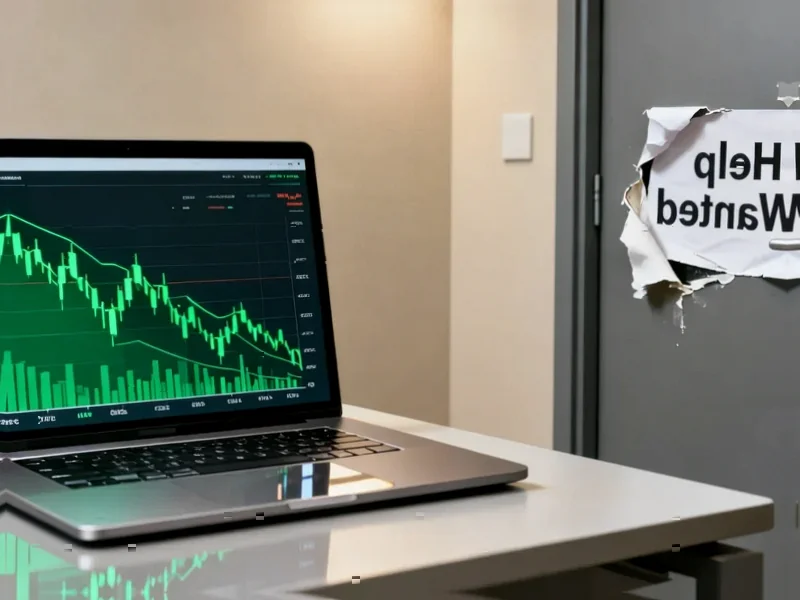According to Fortune, Wall Street opened sharply lower with the S&P 500 sliding 1.2% and the Nasdaq composite sinking 1.7% in early Tuesday trading. The Dow Jones Industrial Average fell 431 points as Big Tech stocks that drove this year’s rally reversed course. Palantir Technologies plunged 10% despite reporting third-quarter earnings that beat Wall Street targets, while Nvidia dropped 2.8%. Federal Reserve officials including Chicago President Austan Goolsbee expressed nervousness about inflation remaining above the 2% target for four and a half years, casting doubt on further rate cuts this year. Global markets followed suit with France’s CAC 40 losing 1.3%, Germany’s DAX dipping 1.5%, and Japan’s Nikkei 225 falling 1.7%.
The AI Hangover Hits Hard
Here’s the thing about market frenzies – they always end with a headache. Palantir dropping 10% after doubling this year? That’s classic “buy the rumor, sell the news” behavior. The company beat expectations, but when you’re trading at insane multiples, good isn’t good enough. You need spectacular. And we’re seeing this across the AI space – Nvidia reversing, other tech names getting hammered. It reminds me of the dot-com era where companies could do no wrong until suddenly they could do no right.
Basically, we’ve reached the “show me” stage of the AI rally. Investors are no longer just excited about potential – they want to see actual profits and sustainable growth. When even blowout earnings aren’t enough to keep stocks rising, you know sentiment has shifted. The AI gold rush is facing its first real test of fundamentals versus hype.
The Fed’s Reality Check
Now here’s what really spooked markets. Fed officials coming out and basically saying “Hey, maybe we’re not cutting rates again this year.” That’s huge for tech companies because they live and die by cheap money. When interest rates are low, investors are willing to pay up for growth stocks that might not be profitable for years. But when rates stay high? Suddenly those future earnings look a lot less attractive.
Goolsbee’s comments about inflation trending the wrong way were particularly damaging. We’ve had four and a half years of above-target inflation, and the Fed is getting nervous about declaring victory too soon. For investors who piled into tech expecting multiple rate cuts, this is a bucket of cold water.
It’s Not Just AI Stocks
But the pain isn’t limited to tech. Getty Images slumped 8.2% after losing its copyright case against Stability AI. That’s significant because it shows the legal risks piling up around AI companies. We’re seeing a wave of these lawsuits from content creators who don’t want their work used to train AI without compensation.
Tesla dropped 2.7% too after Norway’s sovereign wealth fund said it would vote against Elon Musk’s massive compensation package. When one of your biggest investors rebels, that’s never a good sign. And honestly, a $1 trillion pay package? Even for Musk, that seems… ambitious.
The global nature of this selloff tells you something. Europe down, Asia down, bonds reacting – this isn’t isolated profit-taking. It’s a coordinated reassessment of risk. Markets had gotten way ahead of themselves, particularly in tech, and now we’re seeing what happens when reality intrudes.
So What Comes Next?
Look, I don’t think this is the end of the AI story. The technology is real and transformative. But markets tend to overshoot in both directions. We went from skepticism to euphoria, and now we’re settling somewhere in between. The question is whether this is a healthy correction or the start of something worse.
The Fed’s next moves will be crucial. If inflation data keeps coming in hot, we could be in for more pain. And with companies like Tesla facing their own challenges and legal battles heating up across the AI landscape, investors have plenty to worry about beyond just interest rates.
Basically, the easy money’s been made in AI stocks. From here on out, it’s going to require more discernment and less FOMO. And that’s probably a good thing for everyone except the bagholders.
Continue Reading: Related Articles
Business
Business
Business
Cybersecurity
Technology




